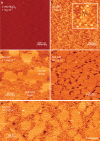Observing classical nucleation theory at work by monitoring phase transitions with molecular precision
- PMID: 25465441
- PMCID: PMC4268696
- DOI: 10.1038/ncomms6598
Observing classical nucleation theory at work by monitoring phase transitions with molecular precision
Abstract
It is widely accepted that many phase transitions do not follow nucleation pathways as envisaged by the classical nucleation theory. Many substances can traverse intermediate states before arriving at the stable phase. The apparent ubiquity of multi-step nucleation has made the inverse question relevant: does multistep nucleation always dominate single-step pathways? Here we provide an explicit example of the classical nucleation mechanism for a system known to exhibit the characteristics of multi-step nucleation. Molecular resolution atomic force microscopy imaging of the two-dimensional nucleation of the protein glucose isomerase demonstrates that the interior of subcritical clusters is in the same state as the crystalline bulk phase. Our data show that despite having all the characteristics typically associated with rich phase behaviour, glucose isomerase 2D crystals are formed classically. These observations illustrate the resurfacing importance of the classical nucleation theory by re-validating some of the key assumptions that have been recently questioned.
Figures





References
-
- Kashchiev D. Nucleation—Basic Theory with Applications Butterworth-Heinemann (2000).
-
- Gibbs J. W. On the equilibrium of heterogeneous substances. Trans. Connect. Acad. Sci. 16, 343–524 (1878).
-
- Gibbs J. W. On the equilibrium of heterogeneous substances. Trans. Connect. Acad. Sci. 3, 108–248 (1876).
-
- Volmer M. & Weber A. Keimbildung in übersazttigten Gebilden. Z. Phys. Chem. 119, 277–301 (1926).
-
- Farkas L. Keimbildungsgeschwindigkeit in übersazttigten Dämpfen. Z. Phys. Chem. 125, 236–242 (1927).
Publication types
LinkOut - more resources
Full Text Sources
Other Literature Sources

